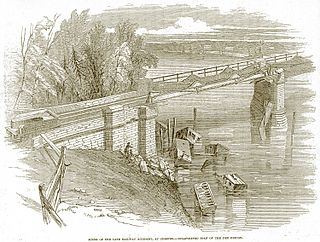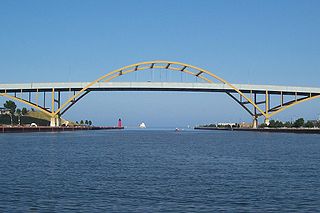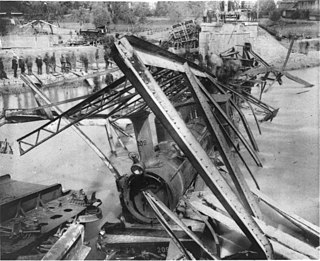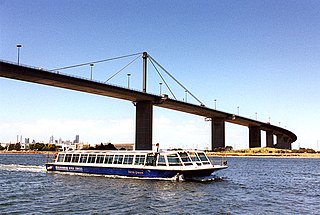 W
WAngers Bridge, also called the Basse-Chaîne Bridge, was a suspension bridge over the Maine River in Angers, France. It was designed by Joseph Chaley and Bordillon, and built between 1836 and 1839. The bridge collapsed on 16 April 1850, while a battalion of French soldiers was marching across it, killing over 200 of them.
 W
WThe Ashtabula River railroad disaster was the failure of a bridge over the Ashtabula River near the town of Ashtabula, Ohio, in the United States on December 29, 1876. A train of the Lake Shore and Michigan Southern Railway carrying about 160 passengers passed over the bridge as it failed. All but the lead locomotive plunged into the river. The train's oil lanterns and coal-fired heating stoves set the wooden cars alight. Firefighters declined to extinguish the flames, leaving individuals to try to pull survivors from the wreck. Many who survived the crash burned to death. The accident killed approximately 92 people. It was the worst rail accident in the U.S. in the 19th century and the worst rail accident in U.S. history until the Great Train Wreck of 1918.
 W
WThe Broadmeadow viaduct, in Ireland, carries the main Dublin to Belfast railway across the Broadmeadow Estuary, about 13 kilometres north of Dublin, just north of Malahide. It is approximately 180 metres (600 feet) long and it is a section of a longer crossing constructed as an embankment. The viaduct carries around ninety trains, including commuter services and heavy freight, per day and it is the sole rail route between Dublin and Belfast. It has had a history of problems with its foundations being scoured out by strong currents.
 W
WThe Dee Bridge disaster was a rail accident that occurred on 24 May 1847 in Chester, England, that resulted in five fatalities. It revealed the weakness of cast iron beam bridges reinforced by wrought iron tie bars, and brought criticism of its designer, Robert Stephenson, the son of George Stephenson.
 W
WThe Dixon Bridge Disaster, also known as the Truesdell Bridge Disaster, occurred on Sunday, May 4, 1873, when the bridge across the Rock River at Dixon, Illinois, collapsed while spectators were observing a baptism ceremony in the river below. The collapse killed 46 people and injured at least 56 others. In terms of total deaths and injuries, the event may be the worst road bridge disaster in American history.
 W
WThe Forest Hills disaster was a railroad bridge accident that occurred on March 14, 1887, in the Roslindale section of Boston, Massachusetts.
 W
WThe Daniel Hoan Memorial Bridge is a tied-arch bridge that connects Interstate 794 in downtown Milwaukee, Wisconsin, to the Lake Freeway across the Milwaukee River inlet. Originally called the Harbor Bridge, it was renamed after Daniel Hoan, one of the longest serving mayors of Milwaukee.
 W
WThe Upper Steel Arch Bridge, also known as the Honeymoon Bridge or Fallsview Bridge, was an international bridge which crossed the Niagara River, connecting Niagara Falls, Ontario, Canada, with Niagara Falls, New York, United States. It was located about 500 feet (150 m) upriver of the present-day Rainbow Bridge. It collapsed in 1938.
 W
WThe I-35W Mississippi River bridge was an eight-lane, steel truss arch bridge that carried Interstate 35W across the Saint Anthony Falls of the Mississippi River in Minneapolis, Minnesota, United States. The bridge opened in 1967 and was Minnesota's third busiest, carrying 140,000 vehicles daily. It had a catastrophic failure during the evening rush hour on August 1, 2007, killing 13 people and injuring 145. The NTSB cited a design flaw as the likely cause of the collapse, noting that a too-thin gusset plate ripped along a line of rivets, and additional weight on the bridge at the time contributed to the catastrophic failure.
 W
WThe Ironworkers Memorial Second Narrows Crossing, also called the Ironworkers Memorial Bridge and Second Narrows Bridge, is the second bridge constructed at the Second (east) Narrows of Burrard Inlet in Vancouver, British Columbia, Canada. Originally named the Second Narrows Bridge, it connects Vancouver to the North Shore of Burrard Inlet, which includes the District of North Vancouver, the City of North Vancouver, and West Vancouver. It was constructed adjacent to the older Second Narrows Bridge, which is now exclusively a rail bridge. Its construction, from 1956 to 1960, was marred by a multi-death collapse on June 17, 1958. The First Narrows Bridge, better known as Lions Gate Bridge, crosses Burrard Inlet about 8 kilometres (5.0 mi) west of the Second Narrows.
 W
WThe King Street Bridge carries King Street over the Yarra River in Melbourne, Australia. The bridge continues south as an elevated viaduct, with the Crown Casino built around it in later years.
 W
WThe Maccabiah bridge collapse was the catastrophic failure of a pedestrian bridge over the Yarkon River in Tel Aviv, Israel on July 14, 1997. The collapse of the temporary metal and wooden structure killed four and injured more than 60 Australian athletes and other team delegates who were visiting Israel to participate in the Maccabiah Games. One athlete died in the collapse and three died afterwards due to infections caused by exposure to the polluted river water. A subsequent investigation found that negligent shortcuts had been taken in the bridge's construction, mandatory permits and oversight had not been obtained, and the bridge's construction did not meet government requirements.
 W
WThe Münchenstein rail disaster on 14 June 1891 was historically the worst railway accident ever to affect Switzerland. A crowded passenger train fell through a girder bridge, killing more than seventy people and injuring many others. The accident occurred on the railway line between Basel and Delémont, near the Bruckgut just below the village centre of Münchenstein, as the train was traversing the bridge across the river Birs.
 W
WThe Quebec Bridge is a road, rail and pedestrian bridge across the lower Saint Lawrence River between Sainte-Foy and Lévis, Quebec, Canada. The project failed twice, at the cost of 88 lives, and took over 30 years to complete, eventually opening in 1919.
 W
WThe Schoharie Creek Bridge was a New York State Thruway bridge over the Schoharie Creek near Fort Hunter and the Mohawk River in New York State. On April 5, 1987 it collapsed due to bridge scour at the foundations after a record rainfall. The collapse killed ten people. The replacement bridge was completed and fully open to traffic on May 21, 1988.
 W
WThe Silver Bridge was an eyebar-chain suspension bridge built in 1928 and named for the color of its aluminum paint. The bridge carried U.S. Route 35 over the Ohio River, connecting Point Pleasant, West Virginia, and Gallipolis, Ohio.
 W
WThe 1940 Tacoma Narrows Bridge, the first Tacoma Narrows Bridge, was a suspension bridge in the U.S. state of Washington that spanned the Tacoma Narrows strait of Puget Sound between Tacoma and the Kitsap Peninsula. It opened to traffic on July 1, 1940, and dramatically collapsed into Puget Sound on November 7 the same year. The bridge's collapse has been described as "spectacular" and in subsequent decades "has attracted the attention of engineers, physicists, and mathematicians". Throughout its short existence, it was the world's third-longest suspension bridge by main span, behind the Golden Gate Bridge and the George Washington Bridge.
 W
WThe Tay Bridge Disaster occurred during a violent storm on Sunday 28 December 1879, when the first Tay Rail Bridge collapsed as a train from Burntisland to Dundee passed over it, killing all aboard. The bridge—designed by Sir Thomas Bouch—used lattice girders supported by iron piers, with cast iron columns and wrought iron cross-bracing. The piers were narrower and their cross-bracing was less extensive and robust than on previous similar designs by Bouch.
 W
WThe West Gate Bridge is a steel box girder cable-stayed bridge in Melbourne, Victoria, Australia, spanning the Yarra River just north of its mouth into Port Phillip. It is a vital link between the inner city (CBD) and Melbourne's western suburbs, with the industrial suburbs in the west, and with the city of Geelong 80 kilometres (50 mi) to the south-west. It is part of one of the busiest road corridors in Australia.